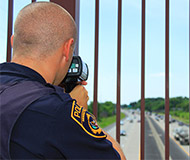Article from: www.thenewspaper.com/news/70/7038.asp
4/21/2021
OPINION: How To Set Speed Limits For Safety, Not Profit
Commentary on the most objective method for setting speed limits when safety, not revenue, is the priority. Part 4 of a series
 By John F. Carr
By John F. Carr
I led off this series by warning that the Federal Highway Administration wants to turn every road into a speed trap. The most dangerous of the hundreds of proposed changes to the Manual On Uniform Traffic Control Devices would delete the existing standard requiring agencies to consider traffic safety when setting speed limits. Here I discuss that standard.
If speed limits are to be meaningful it must be possible to point to facts and say that this limit is too low and this other limit is too high. When "SPEED LIMIT 45" is just some guy's opinion, why is that guy's opinion any better than yours?
In jargon, the "operating speed is a critical factor in determining an appropriate speed limit for a speed zone." In English, speed limits should not be so low that they make everybody a criminal. This has been a recognized standard for 70 years. Using this standard, one can objectively say that this speed limit is good and this speed limit is bad. You will find a disagreement of 5 MPH here and there. What you don't get is one person honestly applying the rule saying speed limit 25 and another saying speed limit 45.
The standard is the so-called "85th percentile rule." If fewer than 85 percent of drivers are obeying the speed limit, the speed limit is probably too low. It doesn't have to be exactly the 85th percentile. The basic principle is people going with the flow of traffic should not get speeding tickets -- not even if they have dark skin and out of state plates. Not even if there is zero-tolerance camera enforcement.
The 85th percentile rule is based on traffic safety. It was observed in the 1960s that vehicles moving with the flow of traffic had the fewest accidents (read study). There is some disagreement about exactly what speed is safest as measured by accidents, dollars or injuries. But it is clear that it makes no sense to hand out speeding tickets to drivers going with the flow of traffic.
The 85th percentile rule is based on democratic principles and the so-called "wisdom of crowds." A large majority of adults are drivers. Behind the wheel they tend to agree on what a safe speed on a road is. Interviewed off the road, it's a different story. They will say nobody should be allowed to drive over 25 on the road they just went 35 on. If you want to know what people think, look at what they do.
It is sometimes said that the 85th percentile rule is for freeways, but not for urban areas. The rule and the leading studies on it predate our modern freeway system. The assertion that people abandon their judgment upon entering the city requires evidence.
It is also often said that the faster you crash the more likely you are to get hurt. So what? That does not tell anybody what the speed limit should be. Is 25 or 55 the right speed limit on this road?
When Scottsdale used speed cameras on a freeway the speed reduction was more harmful than helpful (![]() view study, 420k PDF). When researchers counted injuries to children in Auckland, New Zealand they found that roads with traffic speed around 25-30 were more dangerous than roads with faster or slower traffic but equal traffic volume. In the US you are less likely to die on a 65 MPH interstate than on a 55 MPH two-lane road. Slower is not necessarily mean better. Safety combines accident rate with accident severity, and accident rate is based on human behavior rather than physics.
view study, 420k PDF). When researchers counted injuries to children in Auckland, New Zealand they found that roads with traffic speed around 25-30 were more dangerous than roads with faster or slower traffic but equal traffic volume. In the US you are less likely to die on a 65 MPH interstate than on a 55 MPH two-lane road. Slower is not necessarily mean better. Safety combines accident rate with accident severity, and accident rate is based on human behavior rather than physics.
Under current rules every speed limit alteration is supposed to start with a measurement of the actual speed of traffic. Deviations are supposed to be justified by unusual conditions. Many so-called engineers break the law, but it still exists. Under the rules proposed by the folks in Washington they won't have to break the law to save their jobs. Whatever the mayor wants, the mayor gets. I will explain the consequences in more detail next time.
Part 1. The introduction to this series
Part 2. Proposed changes to stop sign rules
Part 3. How speed limits are set for profit
Read and comment on the proposed rule.
 By John F. Carr
By John F. Carr